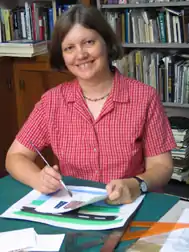Carol Barton
Carol Barton (born 3 June 1954) is a book artist, paper engineer, curator, and educator. She is the proprietor of Popular Kinetics Press and has published several editions of artist books. She may be best known for her series of interactive workbooks, The Pocket Paper Engineer.
Carol Barton | |
|---|---|
 Carol Barton at work in her studio | |
| Born | Carol June Barton June 3, 1954 St. Louis, Missouri |
| Known for | Book Artist, Paper Engineer, Artist, Educator, Curator |
| Awards | Bogliasco Fellowship, Sacatar Foundation Fellowship |
Biography
Barton was born in St. Louis, Missouri. She earned her BFA in 1976 from Washington University School of Fine Arts and graduated as a painting major. While in college, she took a fundamentals class in three-dimensional design, during which she developed a fondness for how objects function from an engineering standpoint. This experience, in combination with her figurative work, seemed an early indicator of her interest in pop-up books.
After moving Washington, D.C. in 1977, Barton was hired as an arts administrator at the Glen Echo Park Arts Center. The Writers’ Center, a resident organization formed by graduates of Visual Studies Workshop in Rochester, New York, presented Barton's first exposure to the book arts. When The Writers’ Center received a grant from the National Endowment for the Arts to produce twenty artists’ books, Barton was invited as a participant in the project. She welcomed the opportunity to explore the book form as an artistic medium.
Barton's first book, Beyond the Page (1981), was produced with use of die cuts and she found it to be a trying experience. She was prepared to abandon her work in the book arts until two things happened: She experienced success when her edition of Beyond the Page sold out and she was exposed by a friend to an early Italian Sleeping Beauty carousel book. She became enthralled with the concept that a book could be both sculptural and mechanical.
Fueled by her renewed interest in the book arts, Barton embarked on a two-year study of movable and pop-up books, which began at the Smithsonian's Dibner Rare Book Library. She traveled to libraries and collections across the United States where she discovered a wide variety of books utilizing sculptural formats and uncommon engineering techniques. As she began to better understand the materials and methods used in the construction of these books, Barton began compiling ideas for the production of her own editions of artist books.
One result of her research was that Barton is credited with reestablishing the tunnel book as a book structure [1] The tunnel format was used in tourist souvenirs and commemorative books as early as the mid-18th century.[2]
Barton started teaching in 1983 at the Pyramid Atlantic Art Center. Through many years of teaching, Barton found that the best way for students to learn paper engineering techniques was through direct, hands-on experience. It was this knowledge that inspired the creation of her workbook series on pop-up design and construction, The Pocket Paper Engineer. Barton continues to teach as a faculty member of The University of the Arts in Philadelphia and in classrooms around the world.
Barton's work has been published in many publications and exhibited internationally. Her work is in many collections, including The Getty Museum, Library of Congress, Museum of Modern Art, The Smithsonian Institution, and the Victoria and Albert Museum in London.
Bibliography
- Barton, Carol (1981), Beyond the Page, Popular Kinetics Press.
- Barton, Carol (1986), Small Gardens, Popular Kinetics Press.
- Barton, Carol (1988), Everyday Road Signs, Popular Kinetics Press.
- Barton, Carol (1988), Tunnel Map, Popular Kinetics Press.
- Barton, Carol (1989), Loom, Popular Kinetics Press.
- Barton, Carol (1990), Rhythmic Notes on Seven Folds, Popular Kinetics Press.
- Barton, Carol (1991), Plant This Book, Popular Kinetics Press.
- Barton, Carol (1993), Instructions for Assembly, Popular Kinetics Press.
- Barton, Carol (1994), A Journal of One's Own: A Handcrafting Kit. Running Press, 1994.
- Barton, Carol (1997), Home Dreams, Popular Kinetics Press.
- Barton, Carol (1998), Vision Shifts, Borowsky Center.
- Barton, Carol (2001), Five Luminous Towers: A Book to be Read in the Dark, Popular Kinetics Press.
- Barton, Carol (2003), Alphabetica Synthetica, Popular Kinetics Press.
- Barton, Carol (2005), The Pocket Paper Engineer, Volume I: Basic Forms: How to Make Pop-Ups Step-by-Step, Popular Kinetics Press, ISBN 0-9627752-0-7
- Barton, Carol (2008), The Pocket Paper Engineer, Volume 2: Platforms and Props: How to Make Pop-Ups Step-by-Step, Popular Kinetics Press, ISBN 0-9627752-2-3
References
- Hutchins, Ed (Winter 2002). "Exploring Tunnel Books". Artists' Books Reviews.
- Wasserman, Krystyna (2007). The Book as Art: Artists' Books from the National Museum of Women in the Arts, p. 130. New York: Princeton Architectural Press. ISBN 1-56898-609-2.
Further reading
- Barton, Carol (2005), The Pocket Paper Engineer, Volume I: Basic Forms: How to Make Pop-Ups Step-by-Step. Maryland: Popular Kinetics Press, ISBN 0-9627752-0-7.
- Barton, Carol (2008), The Pocket Paper Engineer, Volume 2: Platforms and Props: How to Make Pop-Ups Step-by-Step. Maryland: Popular Kinetics Press, ISBN 0-9627752-2-3.
- Barton, Carol (2012), The Pocket Paper Engineer, Volume 3: V-Folds. Maryland: Popular Kinetics Press, ISBN 0-9627752-3-1.
- Gunter, Veronika Alice; & LaFerla, Jane (Eds.) (2004). The Penland Book of Handmade Books: Master Classes in Bookbinding Techniques. New York: Lark Books. pp. 68–89. ISBN 1-57990-474-2.
External links
- Official website
- Beyond the Page: Carol Barton's Art and Influence: a podcast with Carol Barton and the Nashville Public Library
- Interview with Carol Barton via Santa Fe Radio Cafe
- Interview with Carol Barton by Alternative Photography
- Video of Carol Barton creating a pop-up for National Geographic
- Interview with Carol Barton and NPR
- Podcast with Carol Barton and Book Artists and Poets Podcast